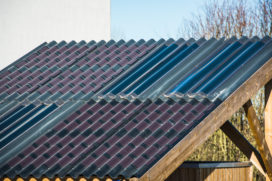Corrugated sheets with integrated thin-film solar cells are being tested in the Wijk van Morgen in Heerlen. This was part of the European innovation project PV OpMaat. Zuyd Hogeschool developed the PV corrugated sheets together with corrugated sheet manufacturer Eternit and solar energy manufacturers HyET Solar and Solliance / MiaSolé.
Heerlen, March 25th 2019
Replace asbestos roofs
“In the Netherlands alone, these thin film products have the potential to replace millions of square meters of asbestos roofs.” This is what Zeger Vroon, professor of Sustainable Energy in Built Environment at Zuyd University of Applied Sciences and senior scientist at Brightlands Materials Center, says.
Thin film versus crystalline silicon
In the field tests, the performance of the developed thin film products is monitored. The performance is also compared to the performance of standard crystalline silicon solar panels.
Carports with solar cells
As part of the practical test, there are two carports in the Wijk van Morgen: a monitoring carport and a demonstration carport. The monitoring carriage is built to map the performance of the standard products. The newly developed thin-film products were applied to the demonstration car. The solar cells of MiaSolé have an efficiency of 12 to 13 percent, that of HyET Solar an efficiency of approximately 9 percent.
Solar panels on stables
“Stables and all kinds of other agricultural buildings built before 1991 cannot cope with the weight of standard solar panels,” says Vroon. The thin film products that have now been developed are specifically intended for stables with weaker structures.
Integrate solar panels
According to Vroon, thin film products can cover almost the entire roof. This is in contrast to crystalline silicon solar panels. “Because of the weight, often only 20 to 30 percent of the agricultural roofs of this type of building are covered with solar panels. With thin film products you can supply 80 to 90 percent PV. ”
Use the flexibility of solar cells
During the construction of the 2 test carports, the situation in the agricultural sector was simulated as much as possible. “The thin film products currently on the market are almost all flat. The flexibility of this type of solar cell is not used, ”says Vroon. “By applying them on corrugated sheets, you do use that flexibility. But it also creates a challenge because the wavy shape means that the light is not the same everywhere.
Incidence of solar cells
Alex Masolin, researcher at Zuyd University of Applied Sciences: “On a corrugated sheet, the incidence of light can change quickly because every hour a different part of the solar cells is shaded. Our solar cells are dimensioned in such a way that they can handle this optimally. ” The solar cells from Solliance / MiaSolé are arranged in the longitudinal direction and the solar cells from HyET Solar are arranged transversely. “We expect that this will also result in differences in yield.”
Yield thin film cells
The thin film cell test will be completed at the end of August. The main research question is: what is the yield and possible yield loss of the PV corrugated sheets compared to flat thin-film products and standard crystalline silicon solar panels?
Channel formation on solar cells
The effect of channel formation on the solar cells is also central. Researcher Joost Rijkers: “With corrugated iron, the water always drains through the wave in the ‘valley’. This means that the same solar cells are constantly exposed to a large amount of water. The effect of this has never been properly investigated. ”
“No additional mounting system”
According to the researchers, this new technique makes it convenient to apply the solar cells to the corrugated sheets in the factory. “Then you don’t have to use an extra mounting system.” The researchers also argue that it is still difficult in the Netherlands to produce solar power for less than 8 cents per kilowatt hour.
Kilowatt hour price
After the test, the researchers say it will take another 1.5 years before the product is ready for market. Rijkers: “We are now testing the products on a scale of 10 to 20 square meters. To be able to definitively determine the kilowatt-hour price of the product, an even larger-scale test is required. ”
Click here for the article
